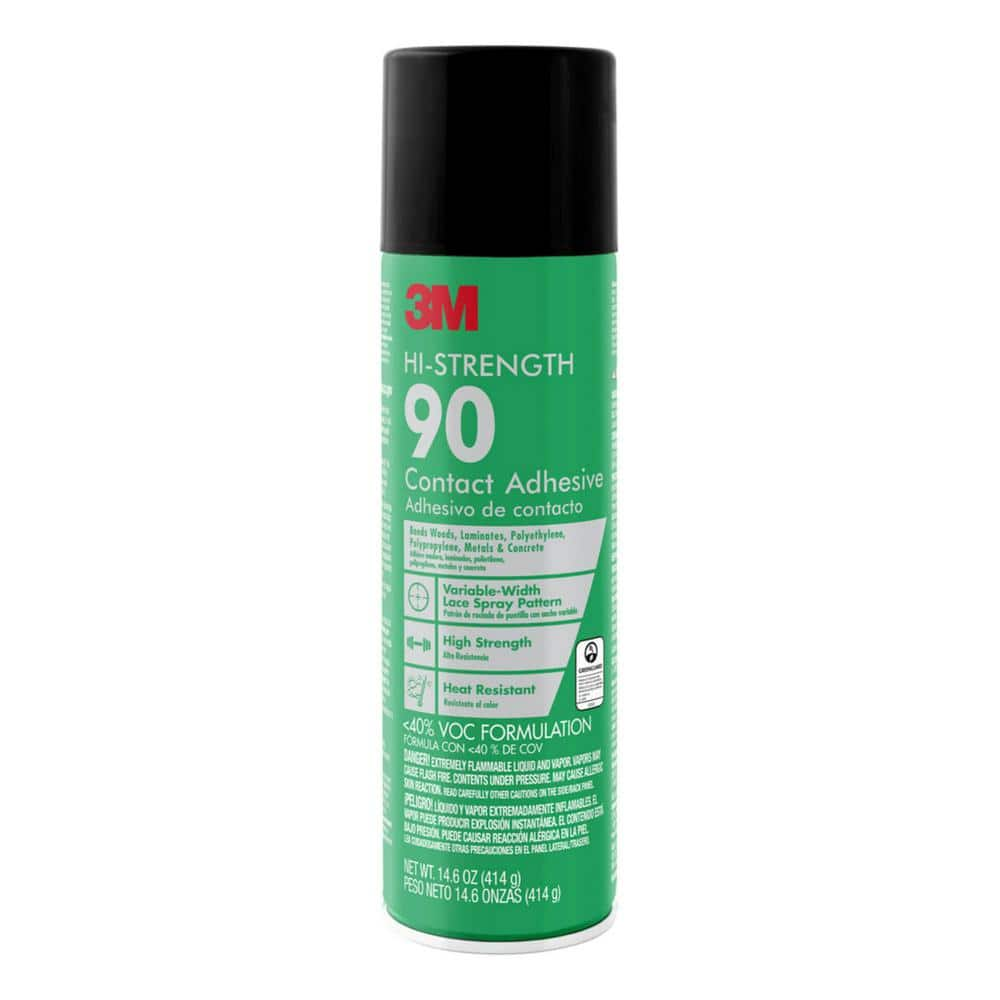The main difference between 3M Spray Adhesive 90 and 77 is their bonding strength and versatility. 3M Spray Adhesive 90 offers high strength and wide coverage, making it suitable for heavy-duty applications, while 3M Spray Adhesive 77 provides a lighter bond but is more versatile in its applications.
In today’s fast-paced world, where time is of the essence, having a reliable and efficient adhesive is crucial for various projects.
Whether you’re working on crafts, upholstery, woodworking, or even automotive repairs, having the right adhesive can make all the difference.
Two popular options in the market are the 3M Spray Adhesive 90 and 77, both manufactured by a leading brand known for its quality products.
We will explore the differences between these two adhesives and help you determine which one is best suited for your needs.

Contents
Adhesive Strength
When comparing 3M Spray Adhesive 90 and 77, one of the primary considerations is their adhesive strength.
Understanding the adhesive strength of each product is crucial in helping users make informed decisions on the most suitable adhesive for their project needs.
Spray Adhesive 90
The 3M Spray Adhesive 90 is renowned for its high adhesive strength. It effectively bonds lightweight materials, delivering a superior strength that ensures long-lasting durability.
This adhesive is ideal for applications where a strong and reliable bond is essential, providing peace of mind that the materials will stay securely in place over time. The adhesive strength of Spray Adhesive 90 makes it a preferred choice for rigorous and demanding projects.
Spray Adhesive 77
On the other hand, the 3M Spray Adhesive 77 offers a versatile adhesive strength, suitable for a wide range of applications.
Its reliable and consistent bonding properties make it an excellent choice for projects that require a moderate level of adhesive strength.
Whether bonding lightweight or medium-weight materials, Spray Adhesive 77 provides a dependable bond that meets various project requirements.
Bonding Materials
When it comes to bonding materials, 3M Spray Adhesive 90 and 77 offer exceptional qualities for various applications.
Compatibility With Substrates
3M Spray Adhesive 90 is ideal for bonding lightweight materials like foils, fabrics, and plastics.
On the other hand, 3M Spray Adhesive 77 is best suited for heavier materials such as metals, wood, and glass.
Versatility In Usage
3M Spray Adhesive 90 provides a strong yet repositionable bond, making it versatile for temporary applications.
3M Spray Adhesive 77 offers a permanent bond, suitable for long-lasting projects that require durability.
Drying Time And Cure
Drying time and cure are important considerations when choosing a spray adhesive for your projects.
Understanding how long the adhesive takes to dry and fully cure can help you plan your workflow and ensure successful bonding.
In this section, we will compare the drying time and cure process of 3M Spray Adhesive 90 and 3M Spray Adhesive 77.
Quick Drying (90)
One of the key advantages of 3M Spray Adhesive 90 is its quick drying time. When you need to bond materials efficiently and swiftly, this adhesive is an excellent choice.
The 90 adhesive formula is designed to tack up quickly, allowing you to move on with your project without waiting for extended periods.
The fast drying time of 3M Spray Adhesive 90 is particularly beneficial for time-sensitive projects or situations where you need an adhesive that sets rapidly.
Whether you are working on crafts, woodworking, or upholstery, the quick drying time of the 90 adhesive minimizes downtime, enabling you to complete your tasks efficiently.
Here are some key features of 3M Spray Adhesive 90’s quick drying time:
- Dries quickly, reducing waiting time
- Enables immediate handling of bonded materials
- Allows for fast production processes
Curing Process (77)
While the 3M Spray Adhesive 90 boasts quick drying time, the 3M Spray Adhesive 77 offers a unique curing process. Curing refers to the time required for the adhesive to fully develop its bond strength.
This is an essential factor to consider, especially if you need a long-lasting and durable bond between materials. The 77 adhesive has a longer curing time compared to the 90 adhesive.
This extended process allows the adhesive to achieve maximum bond strength, ensuring secure and robust adhesion. It is particularly suitable for projects that require a strong bond that can withstand heavy stress or harsh conditions.
Here are the key features of the curing process of 3M Spray Adhesive 77:
- Extended curing time for maximum bond strength
- Creates a durable bond that can withstand heavy stress
- Suitable for projects exposed to harsh conditions
When choosing between 3M Spray Adhesive 90 and 77, consider your specific project requirements regarding drying time and curing process.
Whether you prioritize quick drying or a strong curing process, both adhesives offer distinct benefits to fulfill your bonding needs.

Temperature Resistance
When it comes to choosing the right spray adhesive for your project, temperature resistance is a crucial factor to consider. The adhesive’s ability to withstand heat and cold can determine its effectiveness in various applications.
In this article, we will compare two popular 3M spray adhesives, 3M Spray Adhesive 90 and 3M Spray Adhesive 77, focusing on their temperature resistance capabilities.
Heat Resistance
The ability of an adhesive to withstand high temperatures without losing its bonding strength is essential for applications where heat exposure is involved.
Both 3M Spray Adhesive 90 and 3M Spray Adhesive 77 offer impressive heat resistance, ensuring reliable bonding even in demanding conditions.
- 3M Spray Adhesive 90: With a heat resistance of up to 160°F (71°C), it is a reliable choice for projects that may encounter elevated temperatures. Whether you are working on automotive insulation, HVAC systems, or other heat-related applications, this adhesive’s heat resistance won’t let you down.
- 3M Spray Adhesive 77: This adhesive also offers excellent heat resistance, withstanding temperatures up to 140°F (60°C). It is suitable for projects where moderate heat exposure is expected, such as lightweight bonding in the automotive industry or adhering fabric to foam.
Both adhesives are designed to maintain their bonding strength even when faced with high temperatures, making them suitable for a wide range of applications in varying heat conditions.
Cold Resistance
While heat resistance is important, cold resistance is equally crucial, especially for applications in low-temperature environments.
Let’s take a look at how 3M Spray Adhesive 90 and 3M Spray Adhesive 77 perform when faced with cold conditions.
| Adhesive | Cold Resistance |
|---|---|
| 3M Spray Adhesive 90 | Withstands temperatures as low as -30°F (-34°C) |
| 3M Spray Adhesive 77 | Can endure temperatures as low as -10°F (-23°C) |
Both adhesives demonstrate impressive cold resistance, allowing you to use them confidently in chilly conditions. Whether you are working on outdoor signage, bonding insulation, or any project that encounters low temperatures, these adhesives will keep the bond intact.
Odor And Health Concerns
When considering 3M Spray Adhesive 90 vs 77, it’s essential to understand the potential odor and health concerns associated with these products.
Low Odor Formulation
3M Spray Adhesive 90 is known for its low odor formulation. This means a reduced risk of strong smells that can be bothersome during application.
Health Safety Features
Both 3M Spray Adhesive 90 and 77 prioritize health safety features. These products are designed to minimize health risks for users.
Application Considerations
When selecting the right spray adhesive for your project, it’s important to consider the specific application requirements and environmental factors.
Understanding the key considerations for indoor and outdoor usage will help in determining whether 3M Spray Adhesive 90 or 77 is the best choice.
Indoor Usage
For indoor applications, such as crafts, artwork, or interior décor projects, 3M Spray Adhesive 90 offers a versatile solution.
Its ability to bond lightweight materials, such as paper, cardboard, fabric, and foam, makes it an ideal choice for indoor projects that require a strong and durable bond.
The low misting, precise spray pattern, and fast-drying formula of 3M Spray Adhesive 90 make it easy to use in indoor settings without creating a mess.
Outdoor Usage
When it comes to outdoor applications, 3M Spray Adhesive 77 is a reliable choice. Its high strength and water-resistant properties make it suitable for outdoor signage, outdoor upholstery, and other projects that need to withstand varying weather conditions.
The fast tack and strong bond of 3M Spray Adhesive 77 perform well even in outdoor environments, providing durability and long-lasting adhesion.
Its ability to bond a wide range of materials, including plastics, metals, and wood, makes it a versatile option for outdoor projects.
Conclusion And Recommendations
In conclusion, when choosing between 3M Spray Adhesive 90 and 77, consider the specific requirements of your project and the surfaces involved.
Both adhesives offer distinct advantages, so understanding their best uses is crucial to achieving optimal results. Here are the recommended applications for each adhesive:
Best Uses For 3m 90
- Bonding Heavy Materials: 3M 90 is ideal for bonding heavy materials such as wood, metal, and plastic.
- Tackling Uneven Surfaces: Its high strength and versatile bonding make it suitable for uneven or rough surfaces.
- Permanent Bonding: When a permanent bond is required, 3M 90 is the go-to adhesive due to its exceptional strength.
Best Uses For 3m 77
- Lightweight Materials: 3M 77 is well-suited for lightweight materials like paper, cardboard, and fabric.
- Temporary Bonding: It is excellent for applications requiring temporary bonds that allow for repositioning or easy removal.
- Craft and Decor Projects: 3M 77 is commonly used in arts, crafts, and decorative projects due to its ease of use and versatility.
It is important to select the appropriate 3M adhesive based on the specific characteristics of the materials being bonded and the desired permanence of the bond.
By understanding the best uses for 3M 90 and 3M 77, you can effectively optimize your adhesive choice for various projects.
Frequently Asked Questions For 3m Spray Adhesive 90 Vs 77
What Is The Difference Between 3m 77 And 90?
3M 77 is a multi-purpose adhesive, used for various materials. 3M 90 is formulated for high-strength bonding.
What Is Super 77 Spray Adhesive Used For?
Super 77 spray adhesive is used for bonding lightweight materials, such as fabric, foam, cardboard, and plastic. Its fast-drying, strong bond makes it ideal for crafts, home improvement projects, and industrial applications.
What Is 3m 90 Adhesive Used For?
3M 90 adhesive is commonly used for bonding lightweight materials such as foams, fabric, and plastics. It provides a strong and long-lasting bond, making it ideal for various applications like upholstery, crafts, and even automotive repairs.
Is 3m Super 77 Good For Headliners?
Yes, 3M Super 77 is good for headliners due to its strong adhesive properties and ability to securely bond materials.
Conclusion
After comparing 3M Spray Adhesive 90 and 77, the difference in performance is evident.
For stronger bonds, 90 is preferred. Understanding the specific needs of your project is crucial in selecting the right adhesive.
Consider factors like durability and application ease. Make an informed choice for optimal results.

